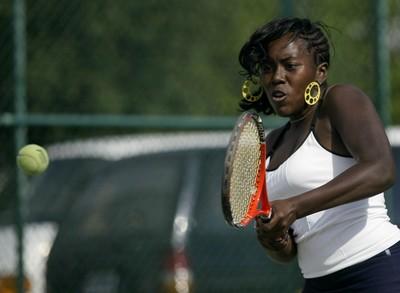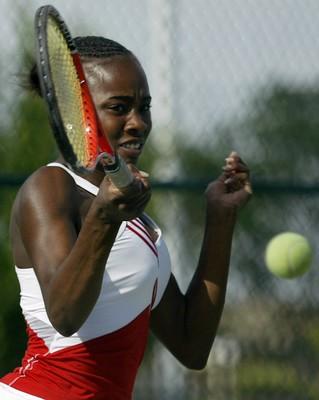Team Agassi strives to win game of life


When Tamilia Hicks and Candynce Boney started playing tennis a few years ago, both thought it would be a short-lived pastime, something to do before moving on to another sport.
Now, tennis is not only their key hobby, it also has been a life-changing catalyst. Both Hicks, 17, and Boney, 18, recently received college scholarships to play tennis.
And, they say, it wouldn’t have been possible without the Andre Agassi Boys & Girls Club tennis program.
Hicks, who joined Team Agassi in 2001, received a $10,000 athletic scholarship from Virginia State University. Boney, who has been with the program for the past seven years, received a full scholarship from the University of Massachusetts. The high school seniors leave for college in August.
Their success is the best example of what the program is designed to do: get at-risk kids into college, says program benefactor Andre Agassi, who donates $250,000 a year to support the program.
“It wasn’t designed to make people go pro as much as it was a vehicle to help kids achieve options and education in their life,” Agassi says.
The program, which started in 1999, targets kids in the neighborhood, says program director Kari Uyehara. The mission is to get at-risk kids off the streets and onto the tennis courts while reinforcing the importance of academics.
All team members attend a three-hour study hall four days a week; they must maintain a B average if they want to travel and play in tournaments with the team, she adds.
The team consists of 25 members of varying ages. So far, three members — including Boney and Hicks – have graduated and all received college scholarships, Uyehara says.
Only members of the Agassi Boys & Girls Club can try out for the team, but anyone can be a member. However, team slots are reserved for those kids who live in the neighborhood and don’t have the same opportunities as kids from affluent neighborhoods, Uyehara says.
Most of the players had never picked up a racket, says Team Agassi coach Tim Blenkiron. He says he uses the game as a metaphor for life, teaching players how to use the principles of tennis to succeed.
Blenkiron’s strategy seems to work; Boney and Hicks both name their coach as their mentor and can quickly voice the impact tennis has made on them.
“If I wasn’t playing tennis, I’d probably be a bad kid. If I hadn’t had anything to look forward to I wouldn’t have cared about school,” says Boney, who started playing when she was 10 and is now nationally ranked in the top 100 of her age group, 18 and younger. “Plus, sports helps you deal with adversity and stuff.”
Her tennis idols are Serena Williams and Angela Haynes, both for their work ethic and off-court behavior. She says she doesn’t know what she wants to major in at college but hopes to turn pro after graduating. If that doesn’t happen, Boney says she’ll work in her degree field.
Hicks always planned to go to college but tennis is giving her the opportunity to attend a historically black college, something she believes will benefit her in her future communications career.
Tennis is just a tool for her, Hicks says, a way to get into college. She wants to work in television production, combining her interest in fashion and tennis to do a segment on the Tennis Channel about the latest fashions in tennis.
Hicks’ tennis idols are Agassi for his integrity and drive; Serena Williams for her power and no-nonsense approach to the game; and Kim Clijsters for her sportsmanship.
“Tennis taught me discipline, confidence, sportsmanship and drive,” says Hicks, who was named Most Valuable Player for four years as a member of her Shadow Ridge High School team. “It’s more of a mental sport. If your mind is not focused on you and staying aggressive, you’ve lost because the first thing to go is the mind, not the body.”












